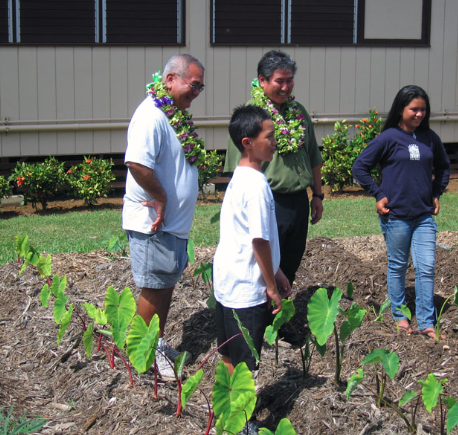Richard Ha writes:
A bunch of things are happening right now. They look very different, but see if you notice what they all have in common.
We are just seeing the tomatoes start to produce more in spite of the dark, wet weather. It’s the third week of February; and last year, too, our tomatoes’ rate of production started climbing in the third week of February. That gives me a good feeling, because I’d been looking around and anticipating this.
All around I see growth. Avocado trees everywhere are choke with flowers right now. The ‘ulu are starting to develop on the tree; the ones I’m watching are about baseball size right now. Everything’s growing and producing around us.
We spent Saturday in Kona at a get-together for Armstrong Produce and its farmers. We stayed there for several hours, talking story with everybody.
I was sitting next to Timothy Choo, a chef from Sodexho, which does food service for UH Hilo. Sodexho is a huge supporter of local products, they go out of their way to buy locally, and we had a big conversation about it. Sodexho is supplied by Suisan, also a big supporter of local products.
I was also talking to Troy Keolanui, manager of OK Farms. Ed Olson owns that farm, 200 acres of many kinds of fruit and other trees, and we help distribute their produce under our Hilo Coast brand.
They are located behind Rainbow Falls, and they have a tent, with chairs in it, where they can sit and look at the falls. They purposely set it up behind some bushes so it doesn’t disrupt the more common view of Rainbow Falls, the one that tourists look at every day.
Then we drove back to this side of the island and went straight
to Puna. Chef Alan Wong was there, and he was throwing a small dinner for the farmers he buys from here.
Alan Wong and I started talking about the Adopt-A-Class project. I
said, “Why don’t we do a broader Adopt-A-Class project this time, in Puna. We’ll take the whole district and go to each of the schools there, including the charter schools. Everywhere there are elementary school kids.”
He’s into it. When we did this in the past, Alan Wong gave a class at Keaukaha Elementary School where he showed the kids how
to use tomatoes, and passed tomatoes around and had some of those kids eating, and loving, tomatoes.
Then yesterday, the folks from Zippy’s came by the farm. They’re going to open up a restaurant at Prince Kuhio Plaza soon and we’ll be supplying some of their products. Zippy’s has a strong “support local” program. When you go into any Zippy’s restaurant, you always see signs about which farms they get some of their products from. Zippy’s also uses local beef. It’s a corporate decision to support local growers.
Do you see the common link among all these things? Everybody’s coming at it from a different point-of-view, but the common
denominator is that we are so lucky to live here in Hawai‘i!
It’s all about local food and making ourselves food-secure. Our tomatoes are thriving and plentiful; where else in the country can you grow tomatoes throughout the winter? Other food is growing all around us.
Armstrong Produce distributes the products of many local farmers and producers. So does Suisan. Sodexo buy that local food.
And Alan Wong, too, is very interested in supporting local farmers and teaching local school kids. He’s very aware of the movement to be self-sustaining and is always reaching out to teach kids about where they come from, how their parents used to live and how we can live now. He’s all about helping people be grounded, and he comes at it with the training of a very high-level chef.
People are really helping each other out. Everybody has to make money, but they’re looking after the next person in the chain. If you’re the farmer, you’re hoping that your wholesaler is caring about you and not just the retailers. Everybody is look after everybody else.
It’s the only way I can figure out that we can help our own workers. Because, of everyone, who’s going to protect the workers? I’ve got to do everything I can to protect them.
There’s a big circle of sustainability around us, and it’s one that’s getting bigger and bigger. It’s really incredible, though it’s easy to get caught up in our busy lives and forget to notice.


